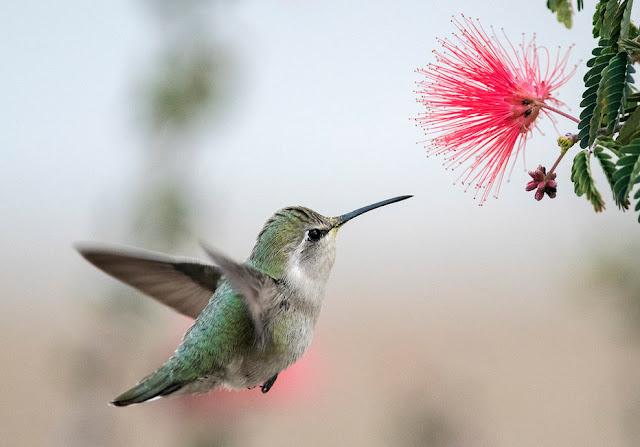Dastardly Duos: Female Anna's and Costa's Hummingbirds
By Larry Liese

Anna's Hummingbird, David Kreidler
FROM THE VERMILION VAULTS
Originally appeared in the March 2003 Vermilion Flycatcher
We all know how much we like looking at hummingbirds—the males that is! Female hummingbirds are just as amazing; they just lack those iridescent gorgets, which make them difficult to identify.
This month we’ll look at two female hummingbirds that can be seen in Southeast Arizona during the cooler months. Anna’s Hummingbird (Calypte anna) nests in winter in our area in a variety of habitats including suburban locations. Some people see them at their feeders all year. Costa’s Hummingbird (Calypte costae) is best seen from February through April, and can be a hard find in late spring and summer.
Like most female hummingbirds, these two are mostly green on their upperparts and lighter below. The female Anna’s however, has grayish underparts washed with green, particularly on the sides, with Costa’s females looking much whiter underneath. Female Anna’s usually have a small amount of metallic flecking on their throat, while any throat markings on a Costa’s will be much less obvious. Anna’s tails look much broader as the outer rectrices of the Costa’s are much narrower. Anna’s wings don’t reach their tail tips, while on Costa’s they are about as long. Anna’s are also said to keep their tails still while feeding, something to watch for.
 |
| Costa's Hummingbird, Francis Morgan |
Both have short, straight (slightly curved on Costa’s), dark bills, noticeably shorter than Black-chinned females. The Anna’s is said to be thicker, but this was not strongly noticeable to me on specimens at the U of A bird lab. Anna’s bodies look sturdy and more solidly built. They average half an inch longer and more than a third heavier, and have a different shape recognizable with experience.
While waiting for a rarity at the Desert Museum, I chanced upon Rick Taylor—one of our local professional guides, who, after I had guessed wrongly on our pair above, imparted this wisdom: “To me, female Costa’s always have a pot-bellied look, while female Anna’s have a flat-bellied look.” Since I’ve noticed that both my friends and myself are usually one or the other, I decided to give this a try. Lo and behold, there is a difference there. Thanks, Rick!
While it’s hard to describe their sounds in print, they are distinctive and many people rely on voice to identify them. Anna’s are one of the most vocal of our hummingbirds, with a loud hard tzip call note, sometimes run together in a series. When chases occur in defense of territories or food sources (seemingly all the time), it becomes a harsh buzzy chatter. Costa’s have a lighter, dry tic call note, with several run together when excited. The male Costa’s display flight produces an unmistakable shrill whistle. When heard, a perched female can usually be found nearby.
This is a pair that most of us can study right in our own backyards. If you don’t already have a nectar feeder, there are many styles to choose from—some that attach right to a window for the close looks you’ll want to follow these hints. Good luck!

Comments
Post a Comment
Thanks, we value your opinions! Your comment will be reviewed before being published.